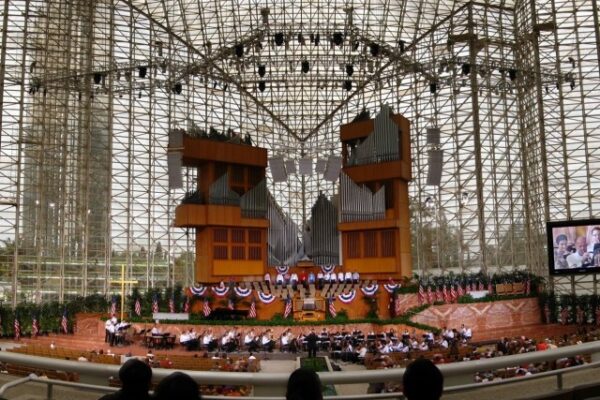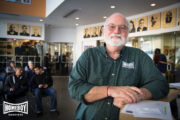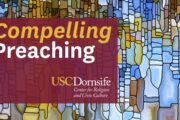This post originally appeared at Trans/Missions, the USC Knight Chair in Media and Religion site.
The past tumultuous few years for the Crystal Cathedral have included the retirement (and un-retirement, then subsequent re-retirement) of the Schuller pater familias; the son’s inheriting the family business only to be replaced by his sister (his sister!); the church’s filing for bankruptcy—a process that exposed both the nepotistic hiring practices and high salaries enjoyed by church employees—and a recent “covenant” that looked to outside observers like a ploy to root out gay men and lesbians from the choir and church orchestra. And now the Crystal Cathedral has entered into an agreement to sell its property in order to exit bankruptcy and pay off the $50 million debt it has amassed.
It’s not exactly clear from recent reports how the sale of the property will actually be consummated or how it will net the amount of money necessary to pay off all of the organization’s creditors. The church has apparently worked out a deal to sell the property for $46 million to a Newport Beach developer, who will then lease it back to the church for $212,000 per month. The church can eventually re-purchase the property within the next four years for $30 million. Somebody is going to lose money on this deal, although it is not exactly clear who that might be at this point. An in-depth investigation of the church’s finances, including how this real estate deal is structured and who is involved, would be an excellent place for reporters to begin digging into the big business of the Crystal Cathedral and other megachurches whose eras may be coming to an end.
Beyond the specifics of the property sale, some observers are making the argument that the plight of the Crystal Cathedral heralds the impending demise of the megachurch and that smaller, niche-marketed congregations will ultimately take its place in the American religious economy. Others say that the Crystal Cathedral has always been an outlier in the megachurch world and, as such, should not be taken as a harbinger of doom for the 1,200 other megachurches across the country.
Regardless of the future form(s) of Christian churches in the U.S., the current mess from which the Crystal Cathedral is working to extricate itself does expose several issues that virtually every megachurch will have to deal with at some point. Megachurches are big businesses that require significant operating capital, including salaries for staff and the maintenance of enormous physical plants. Further, they operate in a highly competitive religious marketplace that often includes nearby competitors (there are 15 megachurches within 10 miles of the Crystal Cathedral and over 100 in the rest of Southern California). Probing both the internal dynamics of these organizations as well as how external cultural changes contribute to their success or failure is important if reporters want to help their audiences understand the ongoing role of megachurches in their communities and in the larger social landscape.
For example, reporters might ask, Are attendees only there because of a particular leader, or do other factors–music, programs, doctrine, location–matter more? Do issues related to leadership succession shape a given institution’s appeal in the religious marketplace? And is there a way to gauge the tipping point at which the expense of running a large institution begins to degrade its sense of mission?
Offering audiences a fine-grained examination of whether and how megachurches will be able to remain competitive in the American religious marketplace is a way for journalists to show the intimate relationship between religious movements and trends in the larger social environments they inhabit. Are flourishing megachurches like neighboring Saddleback or Lakewood in Houston immune from the Crystal Cathedral’s ills, or are they destined to catch a chill too. In any case, considering the degree to which history, politics, financial intrigue and family drama also come into play, the story of the Schullers’ religious fiefdom is also just a really good story.
Richard Flory is the executive director of the USC Center for Religion and Civic Culture.





